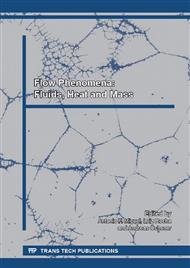p.88
p.97
p.118
p.126
p.135
p.144
p.151
p.157
p.166
Numerical Simulation of Thermofluid Dynamics of Pollutants’ Dispersion by Thermal Electricity Production
Abstract:
The growing global demand for energy has led researchers to seek the improvement of technology in order to maximize the generation of electricity by different ways. Among the different methods of production is the energy produced by thermal power plants, which account for more than 60% of the energy produced in the world. This energy is generated through combustion of fuels such as coal, diesel oil, natural gas and others. The main problem caused by the production of thermal energy is the emission of gaseous pollutants into the atmosphere, such as carbon dioxide (CO2), sulfur dioxide (SO2), nitrogen oxides (NOx), and also particulate matter which causes environmental problems such as acid rain, greenhouse effect, and health problems, especially respiratory diseases. Computational fluid dynamics (CFD) is presented as an important tool in solving problems involving the dispersion of chemicals into the atmosphere. In this sense, this study aims to evaluate the thermofluid dynamics of pollutants’ dispersion emitted from the chimney of a thermal power plant, based on numerical simulations using the Ansys CFX 12.0 commercial code. Fields of velocity and mass concentration of the component involved in the process are presented and analyzed.
Info:
Periodical:
Pages:
135-143
Citation:
Online since:
April 2016
Price:
Сopyright:
© 2016 Trans Tech Publications Ltd. All Rights Reserved
Share:
Citation:


